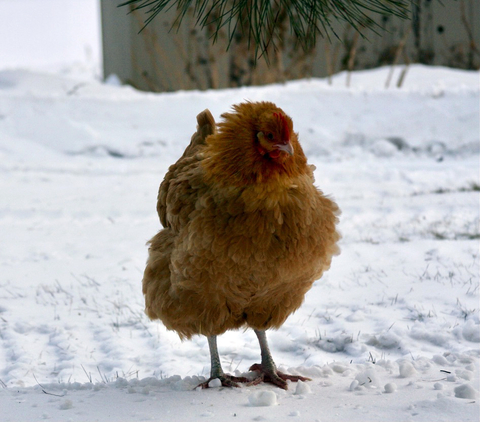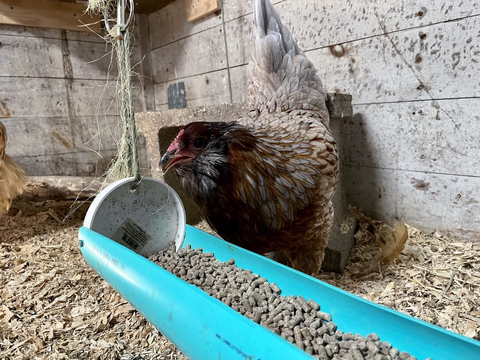Quick facts
- Provide supplemental heat when coop temperatures fall below 35 degrees F.
- Collect eggs as soon as you can and throw away any with cracked shells.
- Make sure your chickens have free access to fresh, clean water.
- Manage manure and provide ventilation to control moisture in your coop.
- Heavier standard and dual-purpose breeds can handle the cold better.
Cold stress
Most poultry can maintain their body temperatures when the environmental temperature is between 60 and 75 degrees F. Within this range, poultry produce and lose body heat in balance. Proper care during cold weather is key to keeping your chickens happy and healthy.
- The average body temperature of a chicken is 106 degrees F.
- Low environmental temperatures can lead to cold stress in poultry. A chicken’s body temperature lowers when it loses more heat than it can produce.
- Huddling together, holding a foot up to their breast, or puffing their feathers are all signs that your chickens may be cold.
- Prolonged cold stress can reduce performance and lead to death.
Select winter-hardy breeds
Not all breeds of chickens will handle cold weather the same. Heavier breeds such as Plymouth Rock, Wyandotte, Ameraucana and Orpington over-winter well. Smaller breeds have less feathering, or have large combs and wattles and may need extra care to stay warm, maintain body weight and keep healthy during cold weather.
If you have a mix of breeds in your flock, consider separating them by size or dominance during the winter. Heavier or more dominant breeds may peck on others and keep them away from the feed, water or roost. As a result, chickens of lighter or less dominant breeds may not get what they need to maintain body weight, health or warmth. Before winter, spend some time watching the behavior of your birds to decide if you will need to separate your flock.
Prepare your coop
A coop is essential to protect your chickens from precipitation, wind and predators year-round. There are several steps you can take to make your coop ready for winter.
Provide roosts
Roosts offer an elevated space for chickens to rest overnight, which keeps them off the cold floor. While roosting, chickens can comfortably lay on their feet to warm them. Roosts should provide enough space for the chickens to fluff their feathers and lay together for warmth without overcrowding.
Generally, roosts should start at least 12 inches above the floor of the coop and provide 9 inches of room per chicken. The exact height and dimension of the roost will depend on the size of your coop.
Avoid using metal, plastic, or other materials that retain the cold and may cause frostbite. Wooden 2 x 4- or 2 x 2-inch boards work well.
Manage drafts and insulate your coop
Inspect your coop for holes and cracks that may allow air to flow freely into the coop. Sealing these spots will prevent cold drafts and rodents from entering your coop over winter.
If your coop is unfinished, consider insulating the interior to help retain heat. Make sure the insulation is closed off to prevent chickens from pecking or scratching at it, but also to keep rodents out.
Provide supplemental heat
When temperatures fall below 35 degrees F, provide supplemental heat at the height of the nest boxes or lower rung of the roost. Placing a thermometer on the wall at each of these heights can help you track coop temperatures.
Radiant heat sources heat the birds but not the surrounding air space. Radiant heaters include brooder plates, panels, and hanging heaters.
Be sure that the product you select is approved for use around chickens and livestock. Always read fire risk warnings and follow installation instructions when using heaters. Thermostats in heaters or bought separately can help you better manage their use and reduce electricity costs.
Another option is an approved heat lamp with a heat bulb. Use heat lamps with safety in mind. Always read fire risk warnings and follow installation instructions. Never hang a heat lamp by the cord. Lamps with a cage around the bulb can help prevent the bulb from contacting the bedding if the lamp were to fall.
Keep all wires away from poultry, water, and flammable litter to prevent damage, shocks or fires. Only use extension cords short term. Do not use them to run power to your coop. Always work with a professional electrician when installing electricity in your coop.
Keep coops ventilated
Air exchange within a coop is key to preventing moisture build-up and poor air quality due to ammonia. High moisture in a coop, combined with cold temperatures can lead to condensation, which can cause frostbite.
The amount of ventilation you need depends on the size of your coop and flock. You can achieve ventilation in a few ways.
- Partially open a south-facing window.
- Install roof vents to allow moisture and stale air to naturally leave the coop.
- Place burlap over opened or partially opened windows to encourage air movement.
- Open a small door or window on warmer winter days.
If you smell ammonia or notice moisture collecting on objects or windows within the coop, you need to increase ventilation and clean up manure to help remove moisture.
Manage manure and bedding
Chicken manure is 70% water, which makes manure management key to controlling moisture in your coop. Manure tends to build up under roosts and other perching sites. Installing trays to collect manure below roosts can make cleaning easy.
You also need to manage manure on the floor of the coop. One option is to routinely pick up manure and remove soiled bedding throughout the winter.
Another option is to deeply bed the coop with 4 to 6 inches of straw or shavings. As the top layer becomes soiled, stir the bedding to allow the manure to move to the bottom. Then, add fresh bedding to the top. This option will provide some natural heat as the manure decomposes but requires a deep cleaning in the spring. If you plan to bed deep, placing a 6- to 8-inch kickboard around the doorway can prevent bedding from spilling out of the entry.
Feeding
You can continue to feed your chickens their normal, balanced diet. A balanced diet plays a key role in feather and egg production. Keep in mind that your flock’s feed intake may increase up to 25% during cold weather. Be sure to have extra feed on hand and top off feeders routinely.
Always store feed in an animal and moisture-proof container, such as a metal garbage can, to prevent feed contamination or spoilage.
You will want to provide free access to poultry grit throughout the winter months. Grit helps the chickens break down feed for digestion. Snow cover and limited outdoor access during winter don't allow chickens to scavenge for rocks and other materials that support digestion.
Scratch grains
Scratch grains are mixtures of seeds and grains such as corn, oats, wheat and barley. As a treat, you should only feed scratch grains in moderation. Avoid feeding more than a handful per 10 birds.
Scratch grains can encourage activity within your flock and reduce boredom, especially when they are kept in the coop over winter. Digestion of scratch grains also produces heat. So providing scratch grains before roosting can help chickens stay warm on cold nights.
Other treats
There are a number of treats you can give chickens to keep them active and busy during the winter months. Chickens tend to avoid going outside in the snow. If you have access to hay, laying a little bit in the run may encourage your chickens to go outside, scratch around, and forage the hay.
Chickens also enjoy root vegetables, squash and pumpkins. But not all produce is safe for chickens, including potatoes. Make sure a potential treat isn't toxic to chickens before feeding it to your flock.
Seeds and seed blocks can also entertain your chickens and provide more energy during winter. Remember to feed treats in moderation. Treats should never replace a balanced ration.
Watering
Water is a key part of your flock’s diet and is necessary for digestion. Without water, chickens will stop eating. Your chickens should always have free access to fresh, clean water. During cold weather, you will need to keep your chicken’s water from freezing. There are several commercially available products.
- Plastic, heated founts that plug into an outlet.
- Heated bases that you can place a metal fount on.
- Heated dog dishes. These dishes should be partially covered to prevent birds from stepping into the dish or drowning.
Place your water source on a stand to keep birds from scratching manure and bedding into it while keeping the heating element away from the bedding.
Routinely check and refresh your chicken’s water. If it is frozen, you may need to bring it into a heated area such as a garage or porch to allow it to thaw. It's a good idea to have a second waterer on hand in case one freezes or stops working.
Keep all wires away from poultry, water, and flammable litter to prevent damage, shocks or fires. Only use extension cords short term. Do not use them to run power to your coop. Always work with a professional electrician when installing electricity in your coop.
Managing nest boxes and egg laying
- Continue to keep your nest boxes clean throughout the winter. Replace nesting materials as they become soiled, broken down or sparse.
- Collect eggs as soon as you can. Most chickens finish laying eggs before noon.
- While freshly laid eggs are 109 degrees F, they are largely made of water and are prone to freezing.
- Always inspect your eggs when you collect them and discard any with cracked shells to prevent foodborne illness.
Supplemental light
As daylight shortens, you will want to provide supplemental lighting to encourage egg production.
- For optimal egg production, chickens should have about 14 hours of light daily. You can provide light using a regular lamp and a timer.
- Provide supplemental lighting in the morning hours before sunrise. Chickens can not see well in the dark.
- If you add light after sunset, the chickens will not be able to find their roost when the light turns off. The chickens may spend the night on the cold floor.
- After December 20, daylight will increase. As the days become longer, you will need to adjust your timer so that chickens continue to receive about 14 hours of light daily.
Culling chickens
Part of responsible flock ownership is considering the welfare of your birds. Before winter, inspect your flock for birds that may have a poorer quality of life during cold weather. Old age, low body weight, or poor health can prevent birds from adapting well to cold weather and may lead to prolonged stress and eventually death. While this may be a difficult decision, culling these birds in the fall is likely the most humane care you can provide.
Frostbite
Most cases of frostbite affect a chicken’s comb, wattles and feet. These areas may become black or gray and feel brittle. The main causes of frostbite are high moisture and cold temperatures. So controlling moisture through airflow and manure management during the winter is critical.
- You can apply petroleum jelly to chicken combs and wattles to help insulate them and prevent frostbite damage. Petroleum jelly does not treat frostbite.
- Consult a veterinarian if you have a chicken with frostbite or infection. If left untreated, severe frostbite can lead to loss of the comb, wattle, or foot.
- If a bird with frostbite gets pecked on by others in the flock, move them to a separate space to allow time for recovery.
Reviewed in 2022



